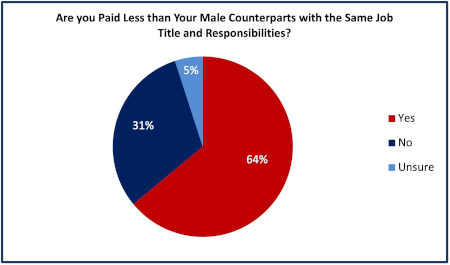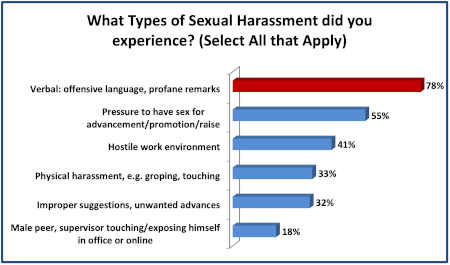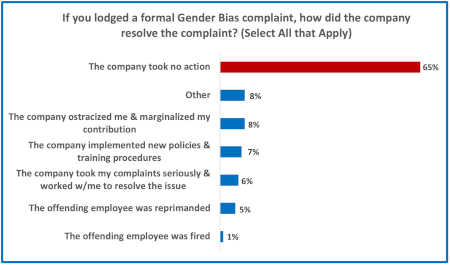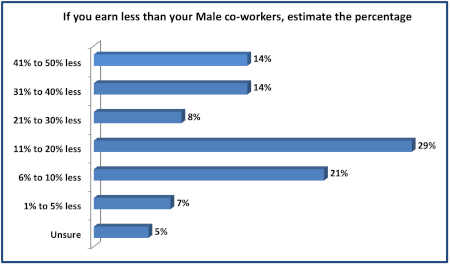The percentage of women professionals in Science, Technology, Engineering and Math (STEM) who said in a survey that they are paid less than their male coworkers for performing similar work jumped to 64%, up from 39% just two years ago.
That was one finding of an independent Web survey conducted by Information Technology Intelligence Consulting Corp. (ITIC), a research and consulting firm in suburban Boston.
ITIC polled 1,850 women STEM professionals worldwide from March through September 2023. The independent Web survey included multiple-choice and essay questions. ITIC also conducted first-person interviews with 30 women STEM professionals who had responded to the survey, to gain deeper context about their experiences.
ITIC accepted no vendor sponsorship money, and none of the participants received remuneration.
The study found that women in STEM professions continue to experience persistent sexual harassment and gender bias, despite heightened awareness and a wide range of Diversity, Equity, and Inclusion (DEI) initiatives aimed at ending such inequities.
Nearly two-thirds (61%) of the women STEM professionals responding to the ITIC survey said they have experienced workplace sexual harassment, while more than three-quarters (78%) said they have been the victims of gender bias.
Exhibit 1. Women STEM Professionals on Unequal Pay

Source: ITIC Corp. 2023 Sexual Harassment, Gender Bias, and Unequal Pay Survey
Top Survey Findings
This is the third poll ITIC has conducted on Sexual Harassment, Gender Bias, and Unequal Pay involving women in the STEM workforce over the last four years. The surveys focus on three crucial areas of workplace discrimination: sexual harassment, gender bias, and unequal pay.
On a positive note, the survey found women increasingly are more willing to take formal action regarding such discrimination, within and without their companies. Approximately three in 10 survey respondents said they had filed complaints within their firms or with state and federal agencies, while 32% of those polled said they left their firms when those employers took no action to address their sexual harassment and gender bias complaints. Additionally, more women STEM professionals reported having initiated legal action about such discrimination, rising from an average of 3% in prior surveys to 7%–9% in the 2023 iteration of the survey.
Observed Kelsey Medeiros, associate professor of management at the University of Nebraska at Omaha where she researches STEM workplace sexual harassment, “We’re seeing a big increase in people calling out sexual harassment, gender bias, and unequal pay because it’s been in the news quite a lot. That’s encouraged women to speak out and share their experiences.”
Nearly two-thirds (61%, or 1,184) of women STEM professionals responding to the survey alleged experiencing workplace sexual harassment, up from the 57% of women STEM respondents who said they had been sexually harassed in ITIC’s prior 2021 poll. The percentage of women STEM professional respondents alleging gender bias rose to 78%, from the 68% who alleged gender bias during their careers in the previous study.
As Exhibit 2 shows, workplace sexual harassment in STEM fields reported by survey respondents runs the gamut from offensive language and profane remarks; pressure to have sex for promotions, raises, and better academic grades; to creating hostile work environment, and even physical contact or assault.
Exhibit 2. Sexual Harassment Takes Many Forms

Source: ITIC 2023 Sexual Harassment, Gender Bias and Pay Inequity Survey
Among the women STEM professionals who responded to the survey that they had been sexually harassed, 78% (881 women) claimed they were subjected to verbal harassment in the workplace that included offensive language as well as crude or lewd remarks about their bodies/anatomy, and profanity.
More than half 55% (666) of the ITIC survey respondents reporting having experienced sexual harassment in the workplace said they had been pressured to have sex in exchange for promises of advancement, promotion, an increase in salary, or even good grades. A third (33%, or 373) of survey participants reporting having experience such harassment said it rose to the level of an actual physical assault, such as touching, groping, or forcible kissing.
Among other survey highlights:
- Of the 61% (1,129) of women STEM survey respondents who alleged sexual harassment, 29% (327) reported filing formal complaints with their company’s Human Resources (HR) departments. Of that number, 61% (689) of the respondents said their employers took no action on those complaints compared with 5% (56) of respondents who said their firms fired the sexual harasser.
- Nearly one-third (32%, or 361) of women STEM professionals who reported they were sexually harassed opted to leave their firms. This is up 4 percentage points compared to the 28% (231) of harassment victims who quit their companies in the 2021 ITIC survey, and a jump of nine percentage points from the 23% (124) women who left their firms in ITIC’s 2019 poll.
- Of the 61% or 1,129 women STEM professionals who said they’ve experienced workplace sexual harassment, 87% (982) women respondents said the harassers were men. This statistic has remained unchanged since the 2019 poll. Another 6% (68) said they were sexually harassed by female colleagues or superiors, and 7% (79) said both men and women had harassed them.
Changing Power Dynamics
The silver lining in the cloud: more women STEM professionals are lodging formal complaints and taking legal action in response to such harassment. In their survey essay responses and in first-person interviews with ITIC, these women STEM professionals cited increased media coverage and the heightened awareness generated by the “Me, Too” movement and Diversity, Equity and Inclusion (DEI) initiatives among the top reasons they felt more confident in coming forward.
Industry researchers tracking these issues said shining the spotlight on unequal treatment of women in STEM is having a positive impact.
The University of Nebraska’s Medeiros, who is also the co-founder of Whisper Coalition, a research group focused on sexual harassment, said there is a perceptible “shift in the power dynamic” occurring.
“Women are pushing back on the traditional patriarchal power [that led to sexual harassment, gender bias, and unequal pay],” Medeiros said. “In academia and universities, the tenured faculty and star researcher positions, particularly in the STEM disciplines, are dominated by men. They stick together, support one another, and cover for one another. That has made it difficult for women STEM professionals in academia to challenge them, let alone win. But things are now starting to change as the abuses are publicly exposed in the media.”
Sexual Harassment
Some 61% (1,129) of STEM women respondents to ITIC’s poll said they have been sexually harassed in the workplace. Of that group, some 59% (666) said they experienced “several incidents involving different people at separate firms;” 34% (384) reported “many/multiple such incidents throughout their careers;” another 29% (327) claimed they had “several incidents involving different harassers at the same firm,” and 9% (10) said they experienced just a single instance of sexual harassment over the course of their professional work life.
Gender Bias
The survey found gender bias allegations among women STEM professionals continuing to trend upwards, with 78% (1,443) of survey respondents reporting they had been victims. This is an increase of 10 percentage points compared with the 68% of respondents who said they’d experienced gender bias in ITIC’s 2021 survey, and the 61% of women STEM participants who alleged gender bias in ITIC’s 2019 survey.
Gender bias, like sexual harassment, takes many forms. This includes being asked inappropriate questions during job interviews, and positional bias (segmenting jobs and titles based on gender). Gender bias also encompasses the “Glass Ceiling,” or the “Pink Ghetto,” in which women get passed over for promotions or are assigned to train male coworkers/peers/subordinates who are promoted ahead of them and above them. Respondents to the ITIC survey also frequently referenced how the “Mommy Track,” their decision to have children, derailed promotions and pay raises.
Out of the 78% (1,443) of women STEM respondents to this year’s survey who said they had experienced gender bias in the workplace, just 9% (130) opted to file a formal complaint with their HR departments. However, a 65% (938) majority of the women STEM respondents said their organizations “took no action to resolve their [gender bias] issues.”
By comparison, 19% (274) of survey respondents those reporting having experienced gender bias said their employers actively collaborated with them to achieve a positive outcome and implement changes. These included new policies and training procedures.
Another 8% (115) retained attorneys, and 2% (29) of survey respondents lodged formal complaints with state and federal agencies. Only 1% (14) of the women STEM survey participants who filed gender bias complaints to their HR departments reported the men were fired.
Exhibit 3. Some 65% of Firms took No Action to Resolve Gender Bias Complaints

Source: ITIC 2023 Sexual Harassment, Gender Bias and Equal Pay Survey
More Women STEM Professionals Act
In first-person interviews with 30 of the survey respondents, the women STEM professionals said ongoing “Me Too” and “Diversity, Equity and Inclusion (DEI)” initiatives made them more confident and willing to initiate action regarding workplace sexual harassment, gender bias, and unequal pay.
The Equal Pay Gap
While the gender pay gap is narrowing, women have yet to achieve parity with men in the overarching U.S. workplace, or in the STEM workforce.
In 1963, women earned $0.60 for every $1 men were paid, according to President John F. Kennedy when he signed the Equal Pay Act into law. The latest 2023 U.S. Bureau of Labor Statistics released in July 2023 found that women are paid $0.84 for every $1 earned by their male counterparts.
By a 2-to-1 margin, the ITIC women STEM survey respondents reported earning less than their male co-workers for comparable jobs. To reiterate, 64% (1,184) of the 1,850 total respondents to the 2023 survey said they earn less than men in STEM, versus 31% (574) of women STEM survey participants who said they were paid on a par with their male colleagues. The remaining 5% (93) were “Unsure.”
As Exhibit 4 depicts, 29% (343) of the women STEM professionals responding to the survey estimated they made 11% to 20% less than their male co-workers, while 28% (332) said their STEM salaries were from 31% to 50% less than their male peers.
Exhibit 4. The STEM Pay Gap Women versus Men

Source: ITIC 2023 Sexual Harassment, Gender Bias and Equitable Pay Survey
Activism vs. Pragmatism
While women STEM professionals are increasingly more proactive in speaking out and making formal complaints, activism is tempered by pragmatism.
In their anecdotal comments and first-person interviews, the women STEM professionals acknowledged they held back in lodging formal complaints for fear they might lose their jobs, be labeled as troublemakers, or suffer reprisals such as forfeiting promotions.
“I wish I would have done something about it, but I was not sure what would happen with my employment,” said one woman, an associate professor of Biology at a Florida university.
Another woman recalled that while she was an undergraduate at a top-ranked New York-based University on a full scholarship, “My physics professor propositioned me, saying he’d give me an ‘A’ for the course if I slept with him. I turned him down, and afterwards avoided him as much as possible, although I did not report him.”
Ollie Fields-Thacker, a veteran STEM educator based in New York, recounted how she chose to deal with a sexually explicit proposition from a male coworker who followed her to her car at the conclusion of a conference. “I unequivocally said ‘No’ and I got in my car and drove off. Thereafter, I ignored him completely.” She opted not to report the incident, noting, “I loved my job and didn’t want any complications. However, if the harassment had escalated to a higher level, I would not have hesitated to report him,” she added.
“Things are beginning to change,” said the University of Nebraska’s Medeiros. “It’s happening more slowly than women would like, but we are making real progress.”
Laura DiDio is principal at ITIC, a Boston-area IT research and consultancy.




Join the Discussion (0)
Become a Member or Sign In to Post a Comment